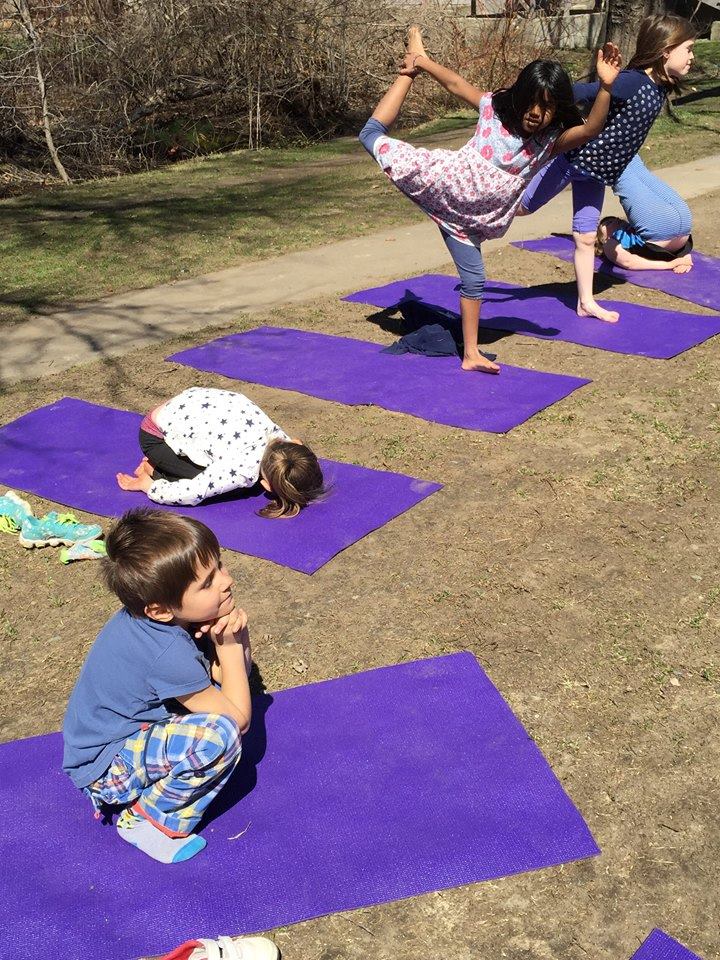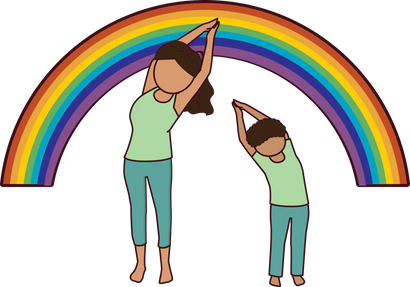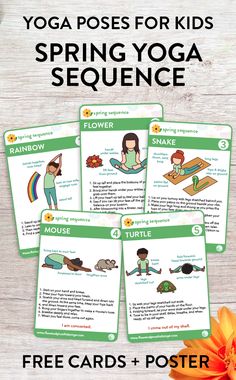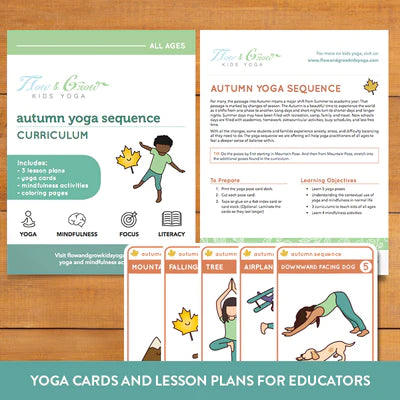Your Cart is Empty

Love for Flora and Fauna -- Yoga and Mindfulness for Kids Can Foster Environmental Stewardship
by Lara Hocheiser July 16, 2020 4 min read 2 Comments
By Kathryn Boland, Flow and Grow Kids Yoga Social Media Manager and Content Contributor
Picture a group of children together outside -- laughing, moving, playing, sharing, and caring. Their teacher picks up a leaf and talks to them about the plant life around them. They pose in animal shapes and replicate animal movements. Is this recess or an outdoor science class? It could actually be a yoga class! As kids yoga becomes more widespread in our culture (even in this new world of COVID, with online classes flourishing), it can be a perfect format to teach children to have a deep respect and caring for the natural world around us.
A cultural awareness that we need to take better care of that natural world isn’t anything new. Yet we’re now confronted with rising awareness about the scientific evidence behind climate change, and how we see its first signs (rising temperatures, changes in animal behavior, and increases in and the number and severity of dangerous weather events, for example). Environmental advocacy in the latter 20th century succeeded in policy action that made our water and air cleaner and safer. Yet too many people still breathe air and drink water that’s not fit for good health -- exhibit A: Flint, Michigan.
Whatever you may believe about climate change and environmental legislation, and the complex sociopolitical dynamics surrounding these topics, we can agree that we want to leave future generations -- and our very own children -- a world that’s safe and pleasant to live in. Environmental stewardship is a value, and values are so often shaped young. There’s no better time to teach people to love and care for wildlife and the wild places where they live than when they’re young. And yoga is a great avenue to do so!
While the main tenets of yoga philosophy don’t explicitly address environmental stewardship, they support it well:saucha (cleanliness),aparigraha (non-attachment), andisvara pradhana(surrender to a higher power), for example. As we move and breathe with young people through yoga, there are so many opportunities to lead them to love of flora and fauna. Let’s look closer at how, specific to different age groups!
If you can bring any of the following kids yoga recommendations into outdoor practice, all the better; being in a natural setting will strengthen what it has to share. Practicing any of them indoors is still quite valuable.
Toddlers and Pre-K -- animal poses and sounds:
This age group loves emulating animals. They already have a love for wild things. Through yoga we can give them an opportunity to express it, and in so doing deepen it! Great poses for this age group are Cat Pose, Cow Pose, Downward Dog Pose, Shark Pose, and Cobra Pose -- all with their respective animal sounds! Giving children an opportunity to vocalize, in an organized manner, fosters a sense of personal autonomy and self-confidence as well as the ability to be in harmony with a group.
With poses like Cobra Pose and Shark Pose, we can also bring a positive view of animals that society often deems dangerous and scary. As kids get older, we can build on this foundation to help them to see thatall animals -- no matter how society views them -- are important parts of the natural ecosystem. They should all be honored and protected. We can also center yoga classes on the seasons, through which they can learn that seasons are part of the natural cycle of our lives and our planet.
Elementary school -- literacy and science integration
As kids learn to read on their own and more about themselves as people, you can help sustain their child-like love of wild things through literacy and science integrated with yoga -- specifically designed to teach kids about nature and immerse them in themes about natural things. For instance, find age-appropriate picture books with beautiful natural imagery and lessons.Yonderis a great one for ages 6-9. Yoga poses that could fit with this book could include Horse Pose, Tree Pose, Downward-Facing Dog Pose, Upward Facing Dog Pose, and more. You can even have students make up their own poses and share with the group, or with a partner (that’s a good approach for kids on the shyer side).
For a science integration, kids could practice poses that emulate different parts of a flower or leaf. A yoga and mindfulness lesson on photosynthesis could include movement and poses representing sun, water, and air (oxygen, with carbon dioxide leaving). A movement sequence with the whole class could illustrate the whole process, with different students representing the plant’s stem, plant’s leaves, soil, sun, water, oxygen and carbon dioxide. What a wonderfully embodied and memorable way to learn! Elementary biology and ecology can be combined with mindful nature walks, creating art from natural found objects and then destroying them (to encouragement detachment, or "letting go"). While not every science lesson can be taught in such an embodied way, with a little creativity many can.

High school: introspection and value-shaping
The teenage years are a turbulent time of life, in large part because it's when we form a lot of who we'll be for the rest of their lives. On one level, like with elementary school, yoga, mindfulness, and movement can support learning in the humanities and sciences (such as anatomy/physiology, health, biology, ecology, cultural and religious histories, philosophy, psychology, et cetera).
On a deeper level, yoga can foster the introspection and value-shaping that builds one's moral and ethical foundation. Where do they stand on issues that affect the environment? In what direction will they take their lives, and how will that impact the world (the environment, society, culture, et cetera)? Journaling, discussion, and prompts for introspective practice (that on their level) can be powerful tools for all of that. Teaching of yoga'syamasandniyamas can offer a digestible framework for that learning and discussion.
Like a house's foundation, in age-appropriate ways throughout youth, we can build up people who will come to love flora and fauna throughout their lives. A little yoga and a little mindfulness can go alongway.
Interested in learning more about kids yoga with different age groups and themes? Flow and Grow Kids Yoga is here to help, with various trainings and products!
2 Responses
Search Ayurvedic
December 07, 2022
The way you are teaching yoga to kids is amazing. I literally loved your method. We have also started such website to teach Yoga to kids in our country. You guys can make a visit once to our website and give a feedback about it.
https://searchayurvedic.com/yoga-for-kids/6-yoga-poses-for-kids-loved-by-93-of-toddlers/
Leave a comment
Comments will be approved before showing up.
Also in Kids Yoga Blog

Easter Yoga Poses for Kids: Joy and Wellness to the Holiday Season
by Lara Hocheiser April 04, 2024 4 min read

Multifaceted Health Benefits of Yoga for Kids
by Lara Hocheiser February 04, 2024 3 min read
Yoga for kids has a transformative power! Holistic practices can enhance mental health, concentration, and physical fitness.

Learn to Teach Kids Yoga Training - Fall 2024
by Lara Hocheiser January 25, 2024 1 min read
In Fall 2024, you will learn how to teach kids yoga. Help empower young minds by learning evidence-based techniques.
Yamas and Niyamas: Successful Relationships with Self & Others (tweens and teens)
digital-resourceskids-yoga-resourceslesson-plansmiddle-high-school-yoga-mindfulnessmindfulnesspricey-content
Yamas and Niyamas: Successful Relationships with Self & Others (tweens and teens)
2 reviews
5.0 / 5.0
(2) 2 total reviews
$55.00
Yamas and Niyamas: Successful Relationships with Self & Others (tweens and teens)
2 reviews
5.0 / 5.0
(2) 2 total reviews
$55.00
Ultimate Kids Year of Yoga Bundle
bundlesdigital-resourcesearly-childhood-yoga-mindfulnesselementary-yoga-mindfulnesskids-yoga-resourcesmiddle-high-school-yoga-mindfulnesspricey-contentseasonal-yogayoga-cards
Ultimate Kids Year of Yoga Bundle
5 reviews
5.0 / 5.0
(5) 5 total reviews
$45.00
Ultimate Kids Year of Yoga Bundle
5 reviews
5.0 / 5.0
(5) 5 total reviews
$45.00
Kid’s Sun Salutation Yoga Cards
digital-resourcesearly-childhood-yoga-mindfulnesselementary-yoga-mindfulnesskids-yoga-resourcesliteracyunder-15yoga-cards
Kid’s Sun Salutation Yoga Cards
3 reviews
4.33 / 5.0
(3) 3 total reviews
$12.95
Kid’s Sun Salutation Yoga Cards
3 reviews
4.33 / 5.0
(3) 3 total reviews
$12.95


















Search Ayurvedic
August 08, 2022
The way you are teaching yoga to kids is amazing. I literally loved your method. We have also started such website to teach Yoga to kids in our country.You guys can make a visit once to our website and give a feedback about it.
https://searchayurvedic.com/yoga-for-kids/6-yoga-poses-for-kids-loved-by-93-of-toddlers/